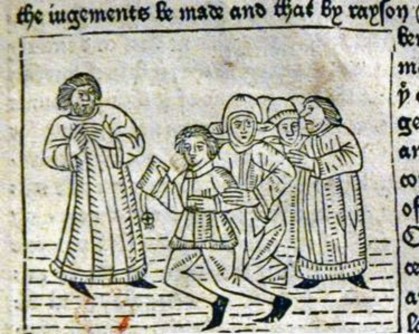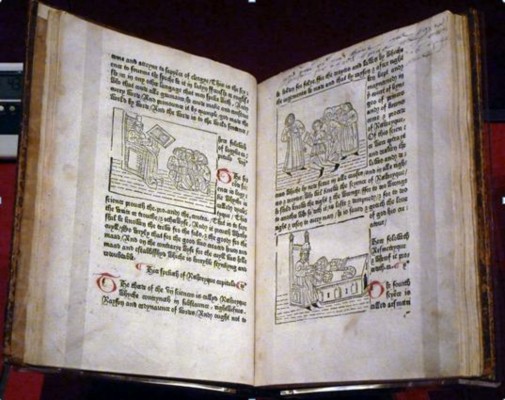The Mirror of the World is one of three books printed by William Caxton amongst the early printed books in the Hart Collection at Blackburn Museum.
Caxton was remarkable. Born in Kent in c.1422 he became a prominent textile merchant in Bruges in present-day Belgium, and undertook diplomatic missions for Edward IV. It was probably Edward’s exile in 1470 during the War of the Roses which led to Caxton leaving Bruges for Cologne where he learnt how to print.
European printing with moveable type originated in Germany. The invention is credited to Johannes Gutenberg of Mainz in the mid-15th century [The Hart Collection also includes a page from the famous Gutenberg Bible]. Printing spread gradually throughout Europe, reaching Cologne by 1465. Caxton returned to Bruges where he set up a press in 1474 and printed seven works in English and French before returning to England in 1476 to establish his press near Westminster Abbey. He died in 1491.

Early printing was a precarious business, expensive to set up and requiring much investment before any income resulted. Caxton wisely decided to go for a market which was not being satisfied from elsewhere: he printed in English. Of the hundred or so books he printed, 75% were in English and 20 of these were translations by Caxton himself.
Consequently, although not an outstanding printer technically, he profoundly influenced the development of the English language and was responsible for making available to a wide reading public the cream of English medieval literature, including Malory’s Morte d’Arthur and Chaucer’s Canterbury Tales.
The first edition of The Mirror of the World (1481) was the first illustrated book printed in England. It is a popular encyclopaedia, translated by Caxton from the French L’Image du Monde by Walter Gossuin of Metz, which was itself derived from Imago Mundi compiled by Honorius Augustodunelsis in the 12th century. Encyclopaedic texts such as this were popular during the Middle Ages, when it was thought possible to include a digest of all human knowledge in a single volume. They were designed to be read all the way through rather than used as an indexed reference work such as a modern encyclopaedia. Honorius’ Imago Mundi, which incorporates the ideas of St Augustine, Bede, Ovid, Homer and Plato amongst others, was a great success and Caxton’s version is one of many translations and  adaptations. The preface declares that “it treateth of the world and of the wonderful dyvision thereof”. In three main parts, the first is about God’s creation, followed by the “trivium” of rhetoric, logic and grammar and the “quadrivium” of geometry, arithmetic, astronomy and music. The second part is on geography and describes Europe, India and Africa, the birds and beasts, weather and the firmament of stars. The final section deals with philosophy, money, the way day and night happen, eclipses, and the size and number of the stars and planets. All this knowledge was designed to lead to a better understanding of God and hence to spiritual salvation.
adaptations. The preface declares that “it treateth of the world and of the wonderful dyvision thereof”. In three main parts, the first is about God’s creation, followed by the “trivium” of rhetoric, logic and grammar and the “quadrivium” of geometry, arithmetic, astronomy and music. The second part is on geography and describes Europe, India and Africa, the birds and beasts, weather and the firmament of stars. The final section deals with philosophy, money, the way day and night happen, eclipses, and the size and number of the stars and planets. All this knowledge was designed to lead to a better understanding of God and hence to spiritual salvation.

The illustrations are woodcut prints which could be printed as part of the text. Caxton’s prints were probably produced in England and are rather primitive. Many are merely illustrative, e.g. Grammar, Logic and Rhetoric. Others are essential to an understanding of the text, such those illustrating the roundness of the Earth and the effect of gravity, both showing a surprisingly modern understanding. Some illustrations are taken wholesale from the manuscript illustrations in L’Image du Monde.
Authorship of The Mirror of the World has often been ascribed to Vincent of Beauvais, who wrote Speculum Maius (or “Great Mirror”), another popular encyclopaedia, but this now seems unlikely. The old label in the Hart Gallery was therefore probably incorrect. It may well be based on a similarly incorrect label written by me more than 30 years ago, which was in turn based on Edward Hart’s own catalogue
15th Century manuscript copy of L’Image du Monde
Mike Millward
NOTE: This article relies heavily on an excellent description of Caxton’s The Mirror of the World which was available on the Glasgow University Library website.
The Hart Gallery
The Hart Gallery is one of the highlights of the museum. It contains an outstanding collection of printed books, manuscripts, icons and ancient writings from around the world, all beautifully displayed.


0 comments on “William Caxton’s The Mirror of the World”